#in the style of botticelli's primavera
Explore tagged Tumblr posts
Text
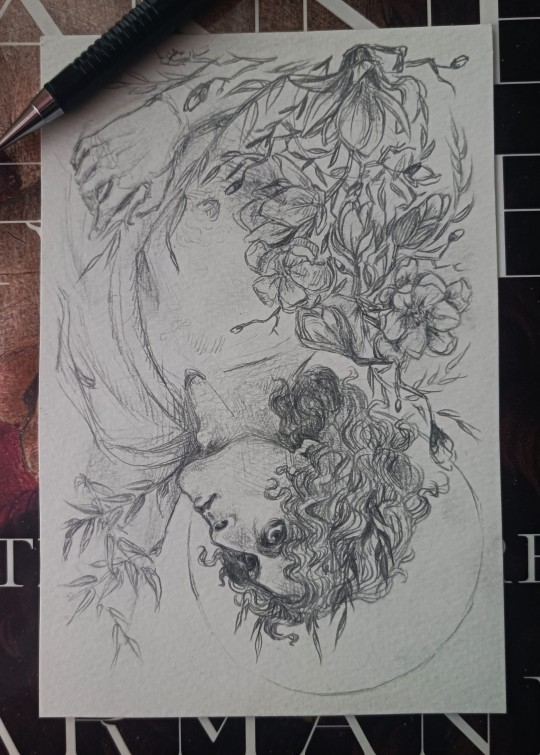
I want to look just for a moment on flowers. To kill, to drink blood and to have flowers.
#amadeo#in the style of botticelli's primavera#with magnolia flowers and myrtle because symbolism#based on the knopf editon cover of tva#finished re-reading this as well#might just be the most beautiful book I own coverwise#myart#iwtv#fanart#armand#pencil sketch#art#armand iwtv#the vampire armand#interview with the vampire#armand amadeo arun#assad zaman
150 notes
·
View notes
Text
The ending of Hannibal the novel explained
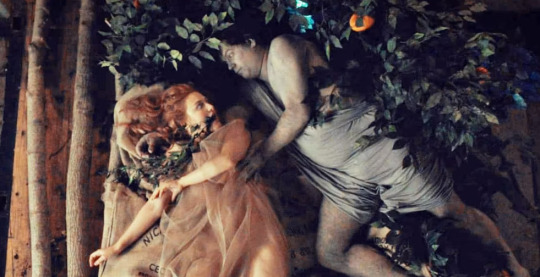
(aka the breastfeeding scene)
Here's the passage (end of Chapter 101):
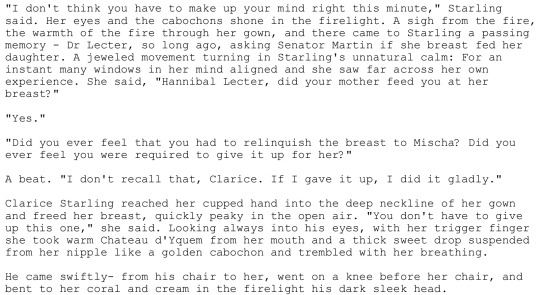
I thought everyone was kidding about the breastfeeding kink jokes until my partner read Hannibal and the whole ending flew over their head. Their main takeaway was "that was weird." When I checked reddit, it seemed everyone was confused there too. I was gobsmacked to see one guy say that Thomas Harris was playing some cruel joke on the reader by writing an ending that didn't make sense!
How many people are reading Hannibal like this, completely missing the resolution to Hannibal's character arc? They must finish the book confused about what it was all about in the first place. So here's how I understand it!
First, I need to get this out of the way: a lot of people hate this scene, and from what I understand it's because they're weirded out by the "breastfeeding kink." Which is fine, but it makes me want to gently hold them by the hand and tell them that it's ok for someone to suck on a nipple. It happens all the time. Sometimes it just feels good, sometimes it's part of a breastfeeding fantasy, and sometimes it's literal breastfeeding. Between consenting adults, this is all fine and normal. Let's all move past this knee-jerk repulsion (or alternatively, sit in our discomfort and expand our horizons) so we can analyze this piece of art together. :)
Next, authors LOVE Freudian psychoanalysis. Even though it's all nonsense, it's full of literary allusion and makes for compelling narratives and character studies (childhood maladjustment, repressed memories, etc), which is basically catnip for a writer. Thomas Harris was no exception, and probably creamed himself (as I did) when he learned that Freud's oral-sadistic stage was also termed the "cannibalistic stage," referring to the time when an infant is growing teeth and begins to bite at the breast--the psychosexual urge to devour and destroy the thing you love. What could be more appropriate for Hannibal?
Next, consider the pattern of Hannibal's Il Mostro murders. He killed young couples in one of the most romantic cities in the world, then arranged them as Chloris and Zephyr from Botticelli's Primavera, exposing Chloris's left breast just like in the painting. In classical art, an exposed breast is often a symbol of fertility. Chloris is associated with spring, new growth, and transformation.
Perhaps, at the time, Hannibal rationalized these murders as retribution for rude behavior. Maybe the couples were performing disgusting PDA. Maybe they were obnoxious tourists on their honeymoons. Either way, it's clear to the reader that Hannibal has some deep-seated hang up about sex and romance.
The particulars of this hang up are open to interpretation, but based on Hannibal's obsession with the rape and transformation of Chloris as well as his embarrassment at the paintings of Leda and the Swan in the German's house, I think it's safe to say that Hannibal feels like any relationship he has with a woman who isn't aware of his true (monstrous) identity would involve a degree of violence/lack of consent. He is forever barred from normal romance.
Having given up on sex/romance, Hannibal is unable to consciously recognize his desire for Clarice, so he sublimates it into a more general familial love. He longs for a return to innocence, to return to the time before he ate Mischa and became an unlovable monster (cue the teacup metaphor).
But even familial love seems like too much to hope for, so he sublimates it further into something that seems more attainable: resurrecting the person whom he loved and devoured, and who loved him in turn (Mischa) through Clarice.
So we have the breast as a symbol of sex/fertility (Chloris/Clarice), as an object that is loved and devoured (Mischa), and as a literal source of sustenance that must be given up during infancy (mommy).
Big brain Clarice connects all these dots and, in the very same style of therapy that Hannibal has been using on her, distills Hannibal's psychological problems into a single poetic gesture that completely fixes Hannibal in an instant, proving that she's not only his intellectual equal, but is, in some ways, his superior.
When Clarice asks, "Did you ever feel that you had to relinquish the breast to Mischa? Did you ever feel you were required to give it up for her?", she's ostensibly asking Hannibal if he's stuck in the oral stage of childhood development (which yeah he probably is). On a deeper level, she's asking Hannibal to consider if he's given up on love.
When Clarice exposes her breast in the same fashion as Chloris, says, "You don’t have to give up this one", and suspends the drop of wine from her nipple, she is shifting his perception of her breast from familial devoured sustenance to a sexual object. Basically, "Why do you want me to pretend I'm your sister when we could be banging?" Hannibal is being aged out of his childlike mindset, not regressing into one.
There are other layers of meaning in this act. The hedonism of using thousand dollar wine for food play is a sign of Clarice's character development. The way Hannibal kneels before Clarice is a position of subservience, but could also be interpreted as devouring Clarice in a way that's new to him. It's the most self-actualized thing Hannibal has done since escaping prison (LOL) and marks the end of his hero's journey (as one of the first things we see him do in Hannibal Rising is nurse).
Personally, I don't read this scene as breastfeeding kink. Yeah, Clarice talks about breastfeeding, but that was more a metaphor for other stuff. Considering the direction of Hannibal's character arc, I understand this scene as him briefly licking the wine off before they have sex. But to each their own! ¯\_(ツ)_/¯
ANYWAY, yeah, it's unsettling. It's obviously meant to be. But it's beautifully unsettling! Hate it all you want, but this is peak cannibal romance, to me!!
103 notes
·
View notes
Text
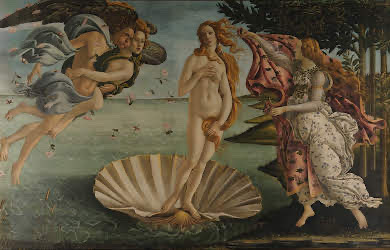
The Birth of Venus
I’m starting a series of sorts where I go in-depth about some art depictions of Lady Aphrodite. Many of these will technically be depictions of Lady Venus, and I know they’re different but in art they are often depicted the same.
The first art piece I’m covering is The Birth of Venus by Sandro Botticelli.
Sandro Botticelli
Sandro Botticelli was born around 1445 and died on May 17, 1510. His actual name was Alessandro di Mariano di Vanni Filipepi. He was an Italian painter of the early renaissance, famous for the Birth of Venus and Primavera, both of which are displayed in the Uffizi in Florence. Botticelli also contributed to the artwork in the Sistine Chapel.
Description of the Painting
This painting depicts the birth of Venus as she emerges from the sea. She is fully nude and standing on a scallop shell. To the left of the painting, Zephyr and Aura blow her towards the shore, where a woman, most likely the Hora of Spring, welcomes her. Venus is depicted with pale skin and long, orange hair.
Creation and Style of the Painting
The Birth of Venus was painted on “two pieces of canvas, sewn together before starting, with a gesso ground tinted blue” (Wikipedia). The dimensions of the painting are 172.5 cm × 278.9 cm (67.9 in × 109.6 in). Though Venus’s pose is classical, many elements of the painting are more of the Gothic style. Botticelli was never completely committed to naturalism, and some parts of the painting (especially her pose) are very unrealistic. Venus’s appearance was modeled after Simonetta Cattaneo Vespucci, a noblewoman from Genoa or possibly Porto Venere. This painting was likely commissioned by someone from the Medici family.
I hope you learned something new, I certainly did and I think I will enjoy this new series! If you have any suggestions for art (paintings, statues, etc) for me to try to create a post similar to this, please let me know! Also let me know if you notice any errors in this post and I will do my best to fix it!
#beautyofaphrodite speaks#beautyofaphrodite shrine#helpol#aphrodite#hellenic community#hellenic deities#hellenic gods#hellenic pagan#hellenic polytheism#hellenic polythiest#hellenic worship#aphrodite greek mythology#aphrodite altar#aphrodite art#lady aphrodite#aphrodite worship#aphrodite deity#aphrodite goddess of love and beauty#aphrodite goddess#aphrodite devotion#aphrodite devotee#aphrodite offerings#venus#birth of venus#sandro botticelli#the birth of venus#painting#art#classical art#venus goddess
46 notes
·
View notes
Text

Title: The Three Graces from Primavera
Artist: Sandro Botticelli
Date: 1485
Style: Renaissance
Genre: Allegorical Painting
189 notes
·
View notes
Text



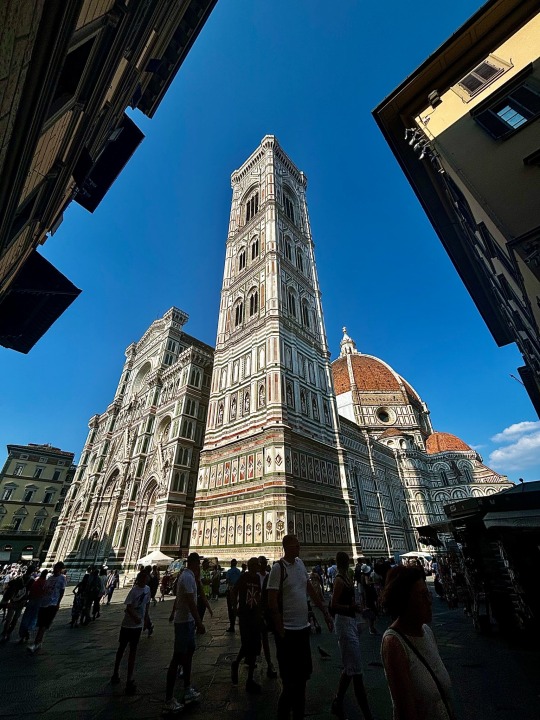


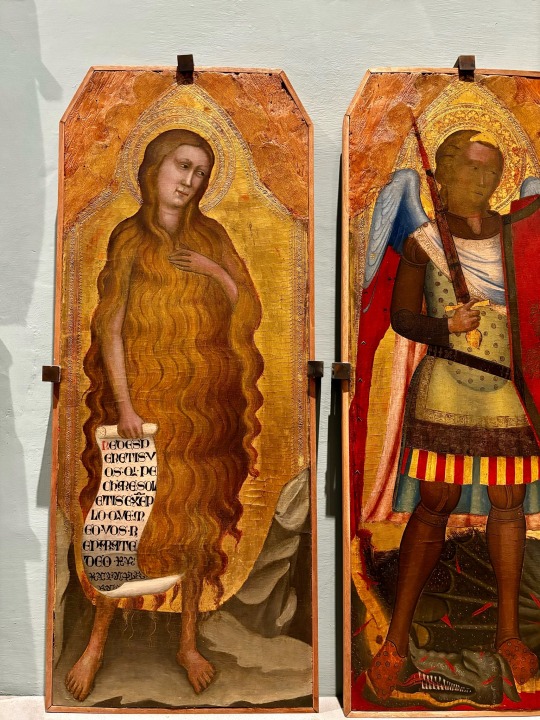
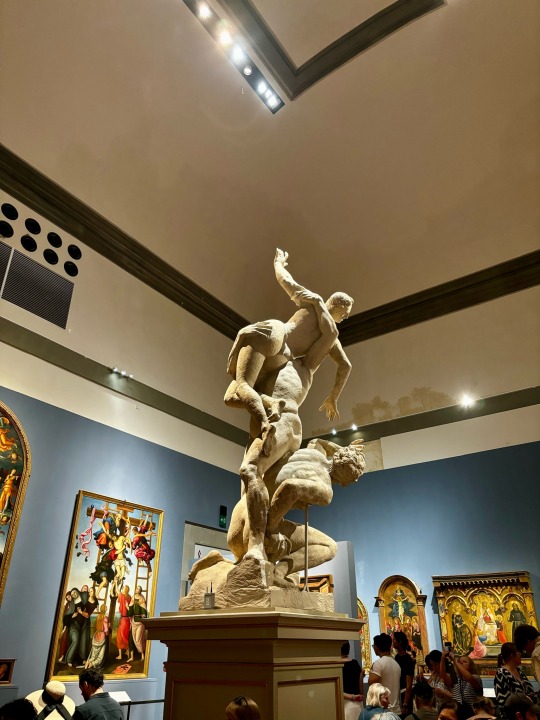


honeymoon;
p a r t . e i g h t
Day eleven July 10
Today we go to Florence. We walk through the Accademia Gallery and see Michael Angelo’s deliberately incomplete statue collection, The Prisoners 1519-1534 and, of course, the statue of David 1501-1504. Here we also see Giambologna’s Rape of the Sabine Woman 1579-1583, in figura serpentinata style. For lunch we go to a famous sandwich shop, All’Antico Vinaio, which is so popular, they have four locations on the same street, each equivalent in quality and each with a line out the door; on our sandwiches, we both opt for pistachio cream; we share a delightful Italian orange soda. We go to the Uffizi Gallery and see various artwork and sculptures; most notably The Birth of Venus 1486 and Primavera 1482 by Sandro Botticelli; Leonardo Da Vinci’s unfinished Adoration of the Magi 1481, Annunciation ~1473 and The Baptism of Christ ~1475. We see the (outside only) Cathedral of Santa Maria Del Fiore, and, naturally, the Duomo 1296-1436; it is as grandiose as one can imagine. We window shop. We go to Venchi for gelato, which has an entire wall of flowing chocolate; we note their product is not covered- to patronize this gelateria would be a divergence from our rule; it is a delicious rebellion. Florence is crowded, the Pigeons have no fear of people and the day has been hot; we return to our B&B and sip crema di meloncello. I spot a Moorish Gecko scaling the stone patio wall. I think we are both quite homesick. (It is impossible to list the plethora of art and artists displayed at each gallery during our time in Florence; all that went unmentioned were no less important and beautiful.)
5 notes
·
View notes
Note
okay let’s do 21 because i know you’re a museum girlie!
What’s your favorite period in art history, your favorite famous work and/or your favorite style of art?
so i don’t have one favorite famous work of art, but i absolutely LOVE 20th century oil painting portraits of rich people taken for no other reason than they can?? i must have like 20+ of them on my phone from museums over the years. but my favorite style of art is abstract expressionism, especially clyfford still, willem de kooning, and mark rothko
I feel like I’ve tricked you into thinking I’m more cultured than I am 😂 because I’m so all over the place when it comes to art, because it’s just like I know what I like when I see it?
Omg YES to the 20th Century oil paintings! Rich people just showing that they have money is always a favorite, I’ve seen one where it was a woman surrounded by like 17 fluffy cats and it’s seared in my brain! Love!
Hmm, if I had to pick a period it would probably be the Rococo period because as a maximalist it speaks to me, the playful opulence of it all! Like here is The Swing from Fragonard, I adore everything about it!
As for works I got to see the Primavera by Botticelli this summer and I literally did not want to leave the room. I love Monet’s Waterlilies, we have one at my art museum and it’s my favorite piece in the whole collection. I think the history behind The Three Witches of MacBeth is so fun because it’s literally about boss babes of the 1770s being boss babes.
But also, here are a couple of my favs from my European Tour!
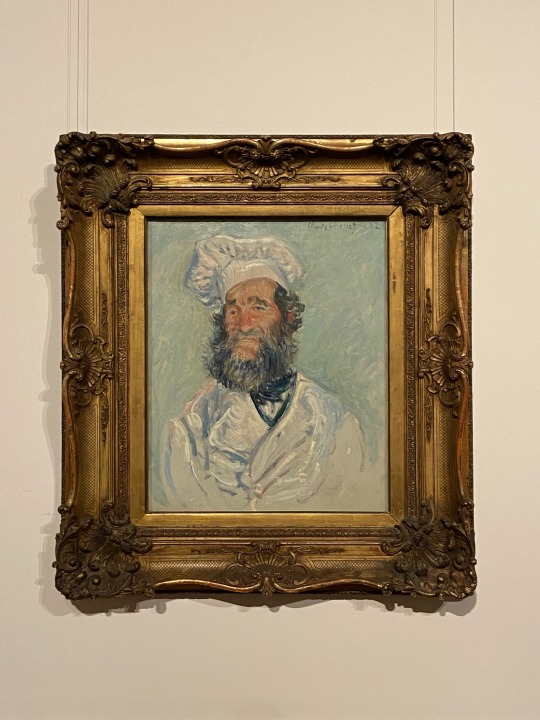
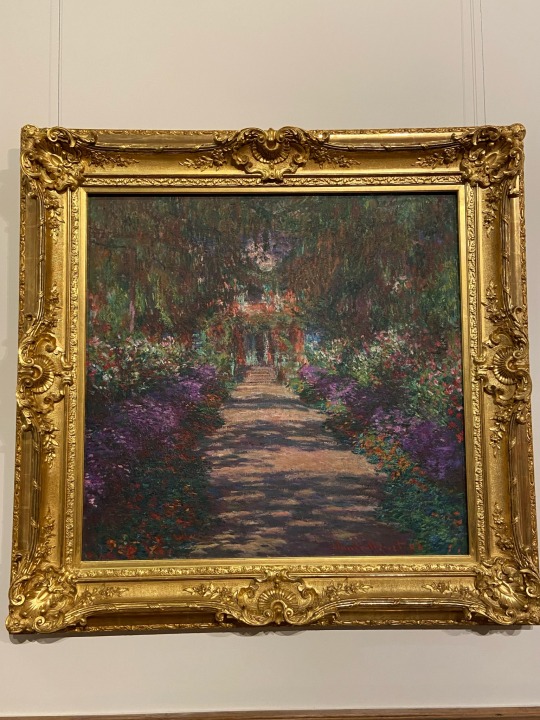
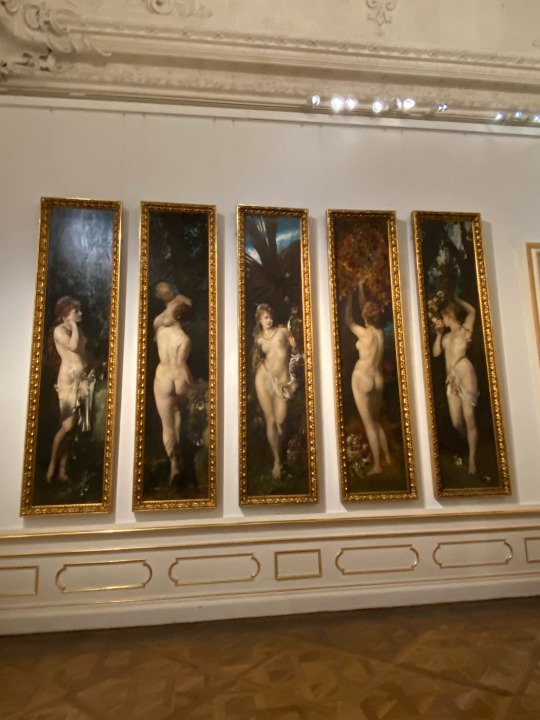
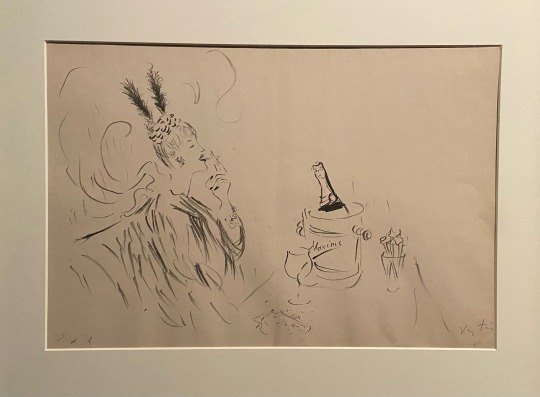
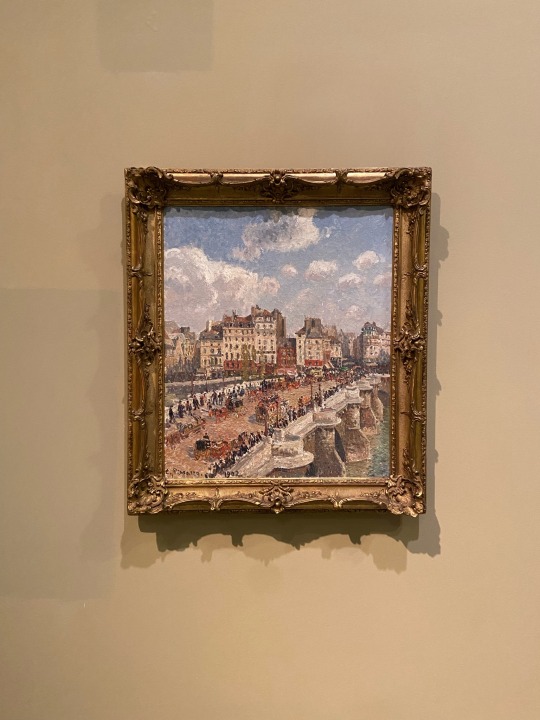
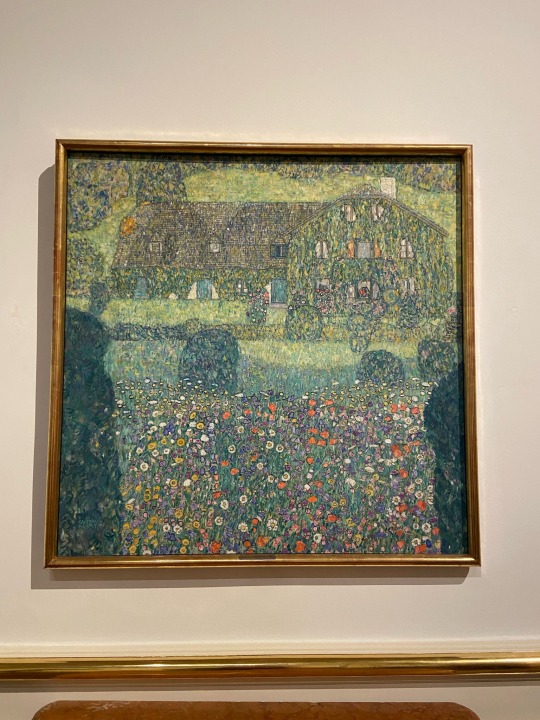
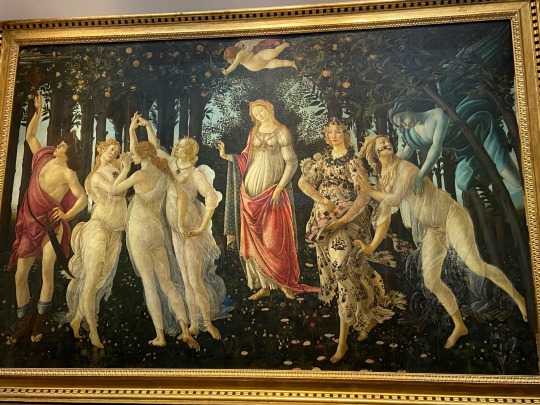
Ask Game with a Twist 💌
#sorry for the delay she got a migraine#I want Anya from Real Girlfriends of Paris to give me a tour of the Louvre#I love that you have a collection of oil portraits saved on your phone!#ok but this is the only way I want to do ask games from now on like YES tell me about you too#answers from alexa#ask game
5 notes
·
View notes
Text
Blog#7
There are so many beautiful artworks to look forward to while we visit Italy, it is hard to choose which I’m most excited about. But One of the works of art I’m eager to see would have to be The Last Supper” by Da Vinci. It has always been an interesting peace to me as my parents spoke to my brother and about what it signified and its meaning. The famous artist Leonardo Da Vinci painted this artwork, and it represents a style of high renaissance. It is in The Covenant Santa maria de Grazie. I am also going to be writing about the artwork Primavera, a painting by Sandro Botticelli.
Primavera is a large panel painting in tempera paint by the Italian Renaissance painter Sandro Botticelli made in the late 1470s or early 1480s. This artwork is in the Uffizi Gallery. It is most known for being a controversial piece because of the meaning behind it and what it may represent. Aside from these places there are countless artworks I’d love to see and learn about. A goal of mine would be to take picture and selfies with these different beautiful art works. Cant wait to share some of these places with you all!
2 notes
·
View notes
Text
Famous Artists Who Used Tempera Colours Painting: Lessons for Modern Artists
Tempera colours painting is an ancient medium that has captivated artists for centuries. Renowned for its brilliant colors, fine detail, and lasting durability, tempera was the medium of choice for many legendary artists, including Giotto, Sandro Botticelli, and Fra Angelico. Their works continue to inspire contemporary artists, offering valuable lessons on technique, composition, and creative expression. In this article, we’ll explore the contributions of these famous artists and uncover key lessons that modern painters can apply to their own practice.
A Brief History of Tempera Painting
Tempera painting dates back to ancient civilizations, including Egypt and Greece. However, it flourished during the Middle Ages and the early Renaissance, before oil painting became the dominant medium. Traditional tempera consists of pigment mixed with egg yolk or other binders, creating a water-soluble paint that dries quickly to a luminous, matte finish.
The precision and vibrancy of tempera made it ideal for religious iconography and detailed portraits. Today, contemporary artists are rediscovering its potential, drawn by its eco-friendly nature and rich history.
Giotto di Bondone: The Pioneer of Realism
Giotto di Bondone (1267–1337) is often considered the father of Renaissance art. He broke away from the rigid, stylized forms of medieval painting, introducing a more naturalistic approach that laid the foundation for Western art. Giotto’s use of tempera can be seen in his frescoes and panel paintings, most famously in the Scrovegni Chapel in Padua.
Key Lessons from Giotto:
1. Embrace Realism: Giotto’s figures were lifelike and emotive, with a sense of volume and depth that was revolutionary for his time. Modern artists can learn from his ability to observe the human form and convey emotion. When working with tempera colours painting, focus on accurate proportions and natural gestures to bring your subjects to life.
2. Master Light and Shadow: Giotto introduced chiaroscuro—the use of light and shadow to create three-dimensional forms. Even with tempera’s quick-drying nature, you can build up layers of light and dark to add dimension and realism to your work.
3. Storytelling through Composition: Giotto’s compositions were carefully arranged to guide the viewer’s eye and tell a story. Consider how you structure your painting to convey a narrative or mood.
Sandro Botticelli: The Master of Elegance and Detail
Sandro Botticelli (1445–1510) is best known for his iconic works The Birth of Venus and Primavera, both created using tempera on panel. Botticelli’s style is characterized by its grace, delicate lines, and intricate details.
Key Lessons from Botticelli:
1. Focus on Fine Detail: Tempera allows for incredibly fine, precise brushwork, which Botticelli used to render intricate patterns, flowing hair, and delicate fabrics. Modern artists can take advantage of this by using fine brushes to add detailed textures and patterns.
2. Create Flow and Movement: Botticelli’s figures often seem to float gracefully, with a sense of rhythm and harmony. When planning your tempera colours painting, think about the flow of lines and shapes to create a dynamic composition.
3. Use Symbolism and Allegory: Botticelli’s works are rich with symbolic meaning. Incorporating symbols or hidden messages can add depth to your work, encouraging viewers to look beyond the surface.
Fra Angelico: The Painter of Light and Devotion
Fra Angelico (1395–1455) was a Dominican friar known for his devotional paintings, including the famous frescoes in the San Marco Monastery in Florence. His use of tempera created ethereal, luminous works that conveyed a deep sense of spirituality.
Key Lessons from Fra Angelico:
1. Achieve Luminous Colors: Fra Angelico’s paintings glow with an inner light, achieved through careful layering of translucent tempera. To replicate this effect, apply thin, transparent layers of paint, allowing the white ground to shine through and illuminate the colors.
2. Maintain a Spiritual Focus: Even if you’re not painting religious themes, consider the emotional or philosophical message of your work. Fra Angelico’s focus on spirituality reminds us that art can elevate the soul and convey profound truths.
3. Balance Composition: His balanced, harmonious compositions create a sense of peace and order. Pay attention to the placement of elements in your painting to achieve a similar sense of equilibrium.
Tempera Techniques Modern Artists Can Apply
1. Layering for Depth and Brilliance:
All the great tempera artists used layering to build up colors and create depth. Begin with thin, transparent layers, allowing each one to dry before adding the next. This technique enhances the luminosity and richness of your tempera colours painting.
2. Precision and Control:
Tempera’s quick-drying nature requires precision. Plan your composition and details in advance. Use fine brushes and steady strokes to create intricate patterns and textures.
3. Embrace the Matte Finish:
Unlike the glossy sheen of oils or acrylics, tempera’s matte finish gives it a unique, soft appearance. Lean into this quality by focusing on subtle gradations and fine details that benefit from the matte surface.
4. Combine Old Techniques with Modern Ideas:
While tempera has a rich history, it doesn’t mean you have to paint like the Old Masters. Experiment with contemporary subjects and styles. The lessons from Giotto, Botticelli, and Fra Angelico can be applied to modern themes, creating a bridge between past and present.
Why Tempera Colours Painting Still Matters Today
In a world dominated by digital art and synthetic materials, tempera offers a refreshing return to natural, sustainable practices. Its vibrant colors, precision, and longevity make it an attractive choice for modern artists who value craftsmanship and eco-friendly materials.
Moreover, studying the techniques of historical masters like Giotto and Botticelli can deepen our understanding of art and inspire us to push our creative boundaries. Their works remind us that great art requires patience, skill, and a connection to deeper themes.
Conclusion: Drawing Inspiration from the Masters
The legacy of artists like Giotto, Botticelli, and Fra Angelico offers a wealth of inspiration for contemporary creators. By mastering the techniques of tempera colours painting and applying the lessons of these great masters, modern artists can create works that are both timeless and innovative.
Whether you’re drawn to the realism of Giotto, the elegance of Botticelli, or the luminous spirituality of Fra Angelico, there’s something to learn from each. So, pick up your brushes, embrace the rich history of tempera, and let the lessons of the past guide your artistic journey into the future.
0 notes
Text
Discover the Diverse Art Forms of the Uffizi Gallery
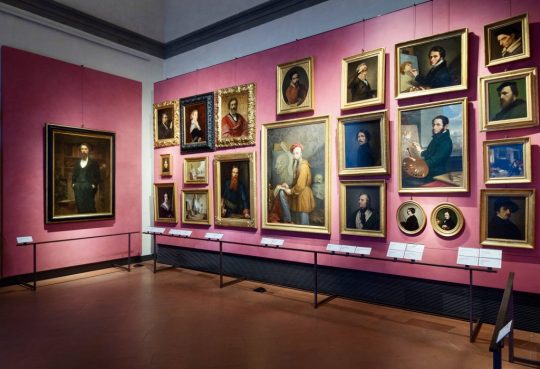
To witness an extensive collection of Italian Renaissance art, the Uffizi Gallery in Florence is the best place to visit. It houses a wide variety of art forms by renowned artists. Not just paintings, the gallery showcases art in different forms. These include:
Paintings: There are numerous Renaissance paintings displayed in the Uffizi Gallery. Some notable works include:
"The Birth of Venus" by Sandro Botticelli
"Annunciation" by Leonardo da Vinci
"Doni Tondo" by Michelangelo
"Adoration of the Magi" by Leonardo da Vinci
"Primavera" by Sandro Botticelli
Sculptures: At the gallery, you will witness an impressive array of classical and Renaissance sculptures. The most stunning creations include:
"The Medici Venus": It is a classical Greek statue of Venus, the goddess of love.
"The Wrestlers": It shows two athletes engaged in a wrestling match. It is a Roman copy of a Greek original.
"Hermaphrodite": Another Roman copy of a Greek original showing Hermaphroditus, the child of Hermes and Aphrodite.
"Laocoön and His Sons": This sculpture shows the Trojan priest Laocoön and his sons being attacked by sea serpents. It is a Roman copy of a Hellenistic original.
Drawings and Prints: The Uffizi Gallery displays an extensive collection of antique drawings and unique prints. These drawings show the preliminary sketches and detailed studies of various artists. These include:
Leonardo da Vinci’s Sketches: These are preparatory drawings and studies by Leonardo da Vinci. These provide insight into his creative process.
Michelangelo’s Drawings: These collections of Michelangelo’s drawings showcase his powerful draftsmanship and skill in capturing the human form.
Raphael’s Studies: Raphael’s preparatory drawings reflect the refined technique used in his final works.
Antiquities: Numerous ancient Roman statues and artifacts are also displayed in the gallery illustrating Renaissance art from the ancient times. Some of them are:
"The Medici Vase": It is a grand and intricately decorated marble vessel used for mixing wine and water. It is a bowl made in classical Greek style.
"The Niobid Group": These are Roman statues that are copies of Greek originals. These depict the tragic myth of Niobe and her children being punished by the gods.
"The Idolino of Pesaro": It is a bronze statue of a young male made in classical Greek style.
"The Medici Torso": It is a fragmentary statue of a muscular structure and dynamic pose typical of classical sculpture.
The Uffizi Museum is an artistic wonder in itself displaying the largest collection of the Renaissance art by gifted artists and sculptors. This gallery showcases the development of art from the Middle Ages to the Baroque period.

Quick tips for Uffizi Gallery Florence visitors:
If you are planning to visit this place, save your energy and time by booking Uffizi Museum Tickets in advance. The place observes thousands of visitors on a daily basis so you may have to stand in a long queue to book your tickets. But with advanced booking, you can choose the day and time you want to visit.
Book a guided tour. Though you can explore the museum on your own, you may get to know several less-known facts about it when you are accompanied by a knowledgeable tour guide. You can request him to communicate in the language you prefer so that you don’t miss any of the significant works displayed here.
Weekdays especially Wednesday and Thursday are the best days to visit the gallery. Mornings are usually less crowded. Arrive early to avoid long Uffizi Museum Tickets queues.
The museum has a cafeteria at the end of the galleries on the first floor from where you can get a cappuccino and enjoy a panoramic view of the area.
1 note
·
View note
Text
Discussing a discussion.
Seeing as this blog is a part of my uni degree, for my contemporary art module, I feel that I should offer a reflection on my first ever contemporary art session. Whilst not technically a “discussion session”, a very interesting conversation certainly took place.
I would in no way describe myself as someone who is familiar with a lot of contemporary art pieces, and likely for this same reason I would not say that I dislike contemporary art. I feel I do not know enough to offer an opinion of distaste which can be sufficiently backed up. Basically I think that to dislike something you should at least know why. Anyway, what I do know is that I always enjoy learning about new art, no matter when it was created.
However, during the first contemporary art session it became clear that numerous people in the group had already made up their minds. That is to say, most preferred older styles or the more stereotypically “aesthetic art” you’d likely find prints of being sold on Etsy for a ridiculous price (think Botticelli’s Primavera). Personally, I love this sort of art too but my favourite kind of art is that which has a story, a deeper meaning with something to say. Often I find that the less immediately obvious the story behind a piece is, the more I enjoy looking at said piece once I know what’s really going on. Take for example the images below of Félix Gonzáles-Torres’ piece untitled (portrait of Ross in L.A.), at first glance the installation is nothing more than a pile of sweets. However, once you learn that the piece is a representation of Torres’ lover’s decaying body, suddenly the 175lbs worth of candy weighs so much more. Thus, I have a lot of time for contemporary art and its sometimes hidden or obscure meanings.

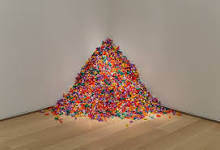
This was not the overall consensus of the group. It seemed as though the lack of a universal definition for contemporary art left people feeling unable to engage. If the audience are already approaching the work from a place of misunderstanding, how can they then be expected to connect with it? This dilemma is one which many curators will attempt to tackle whilst struggling to define the age old question: what even is contemporary art anyway?
It was striking to me that people could just push aside what they didn’t understand, and I would say that once this was brought to attention it shocked everyone else too, including those guilty of doing just that. These days it is so easy to ignore anything that doesn’t provide instant gratification. Constant media consumption has ruined our attention spans and it seems like no one has time to reflect anymore. Not unless prompted anyway. Perhaps that’s why so many claim to dislike contemporary art. Arguably, it requires more than just a brief glance at the piece, viewers are expected to see rather than just look – something which takes longer than the 15 seconds someone may take to appreciate something such as Monet’s water lilies. Not that I don't love those too!!
But therein lies the ‘problem’ with contemporary art. Its discursive nature means there is always room for dialogue between viewer and artwork, something is always up for interpretation. Effort is required to reach a satisfactory conclusion or opinion. This is where people must decide, does art always need a meaning?
As I am writing this reflection close to the end of the semester I have seen the impact of this first session in full. The questions asked certainly prompted people to engage more with contemporary art and to accept that sometimes pieces don’t have a clear interpretation right away. I have witnessed those who previously disregarded contemporary art spend time with pieces they would have deemed ‘pretentious’ at the beginning of the semester. Thus maybe the future of art is dependent on tolerance. As we move further into the digital age and embrace technology such as NFTs, VR, and AI art, viewers will need to adapt to new mediums and be willing to spend time with pieces perhaps presented in an entirely new way. If this is the case then it could be that contemporary art will never have a universal definition as such, but its ever-changing nature may come to define it. And this is just something we will all have to accept - or at least those are my thoughts anyway.

Real footage of me writing this ramble ^
1 note
·
View note
Text
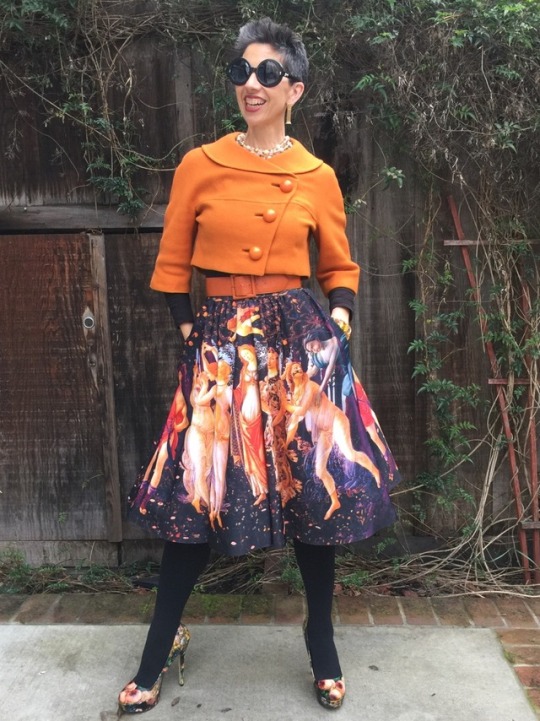
Primavera by Botticelli
Photo by Aman, 3/4/19.
18 notes
·
View notes
Text


Botticelli // Alexander McQueen
#botticelli#sandro botticelli#art detail#la primavera#primavera#the spring#alexander mcqueen#moda#art history#art#artist#artwork#italian artist#italian painter#italian painting#pretty dress#costumeedit#costumes#style#styleinspiration#paralles#reference#fashion#old fashioned#aesthetic#beauty will save the world#beauty
13 notes
·
View notes
Text
Mary Bonnet's Feminist Oeuvre

A lot’s been said about how Mary’s painting style is hundreds of years ahead of her time, but I’d like to talk about how conceptually her oeuvre is a celebration of womanhood and femininity, which stands in contrast to the show’s broader exploration of masculinity. Taking on the moniker The Widow Bonnet, she asserts her identity as an independent woman. Each of her paintings are art historical references to the female form and experience.

First of all, Mary loves to paint large-scale close ups of flowers, an obvious reference to 20th century American painter Georgia O’Keeffe, whose floral works resemble vulvas. Maybe alluding to her sexual reawakening as she rediscovers the joy in sex with Doug.
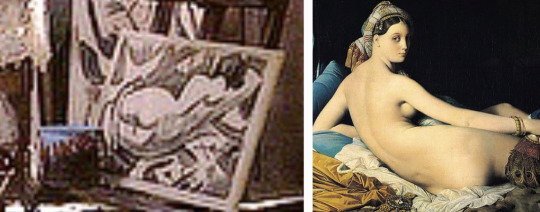
Other paintings seem to be references to works by male artists who painted female nudes, but I think they were chosen carefully. One pose reminds me of Ingres’s Grande Odalisque, which art historians believe signals a shift from the rigid Neoclassical Period towards Romanticism, which I’ll come back to later. The subject here is a concubine- another way besides widowhood that a woman could remain unmarried, though still constrained by male ownership.

The three figures here are a nod to Botticelli’s Primavera, an allegory for spring and fertility, representing a season of rebirth in Mary’s life. Specifically it’s depicting The Three Graces, sisters from Greek Mythology. I like to think this is the community of women she’s found in widowhood. Incidentally, Primavera is set in an orange grove.

With cubist nudes it’s hard not to invoke Picasso’s Les Demoiselles D’Avignon. Another transitional piece between art historical periods, it was controversial for depicting women as confronting and unconventionally feminine. Picasso was a raging misogynist so we’ll just say Mary invented cubism. Love that for her.
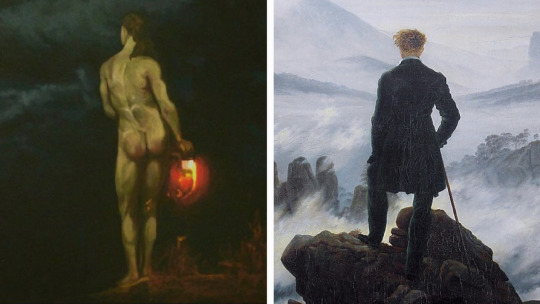
The painting Mary is working on is the most interesting to me. It’s in a completely different style than the rest of her work, and the closest to something you might find in her time. It has the moody chiaroscuro of a Baroque painting, with the looser, expressive brushwork of a Rembrandt. But tonally it strikes me as Romantic, a movement that would arrive about 100 years later. Compositionally it reminds me of Casper David Friedrich’s Wanderer Above the Sea Fog, with a central figure looking out over a cloudy unknown. Over Mary's new independent future. The gender is ambiguous- her practice expresses a liberation from her gender roles but you could interpret this as a liberation from gender in general. It’s another lighthouse painting, really. But instead of an immobile flame guiding others, the figure is free as they are naked to take their light where they please.

What an icon.
#our flag means death#ofmd#our flag means death meta#ofmd meta#mary bonnet#the widow bonnet#art history
2K notes
·
View notes
Note
Hi I want to ask you for some advice. I'm graduating soon and I want to get myself a tattoo as a congrats gift. Can you recommend me a painting/art motif that would look good as a tattoo? Or more if you will! I was thinking about getting the tree dancing ladies from Botticelli's primavera. Does anything come to your mind?Thanks!
Hi! I'd love to help you, but I have to start with the fact that I don't have any tattoos myself, mostly because I'm so indecisive and can't commit. Maybe one day, but not in the nearest future! That being said, I think I know the perfect art style that works for tattoos. In my opinion it's paintings from the style Art Nouveau and by the artist Alfons Mucha, among many others. I used to be obsessed with dainty and detailed little paintings on tattoos, but I learned that they can smudge and blur together a lot with time and lose their details. Art Nouveau however is defined by strong dark outlines and significant contrast, so they won't lose their shape as easily. Apart from that, you can get almost any art nouveau artwork as a tattoo, they work great both in black & white and in color, and you can even get an artist to design a thing you love from popculture and other sources to be in this style and look like Mucha's painting. If you're looking for something more unique than Mucha, I recommend the artist Elisabeth Sonrel, equally talented but not as known!
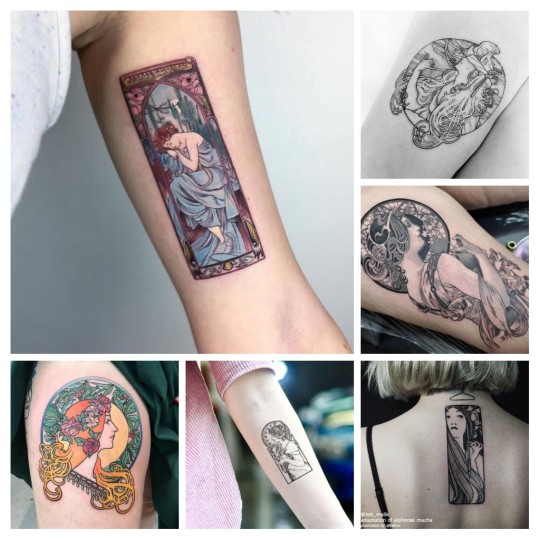
Some inspo from Pinterest (sorry for the lack of sources, but you know how Pinterest is with these things)
33 notes
·
View notes
Note
🖼️ for Beatrice and the same for Stella the patron of the arts ^^ —leila-of-ravens
i was so hoping someone would ask this one thank youuuu, i give a mini art history lesson in this post lol
🖼️ a moodboard of my muses art aesthetic
Beatrice:
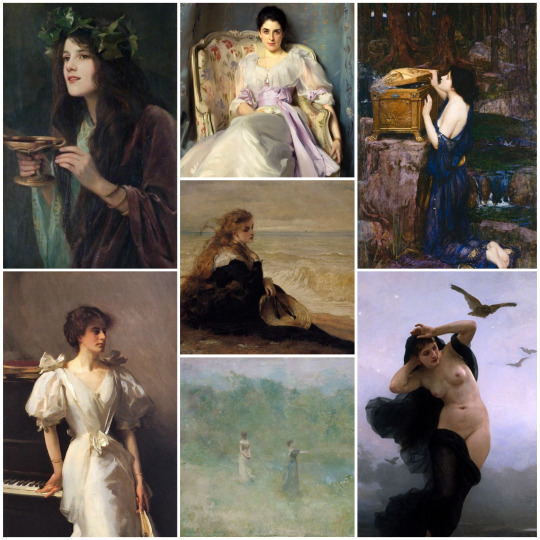
Artists featured: Beatrice Offor, John Singer Sargent, Thomas Dewing, William-Adolphe Bouguereau, George Elgar Hicks, and John William Waterhouse
Her art aesthetic is inspired mainly by portraiture, specifically from the late 19th century. For her, I’m drawn to Pre-Raphaelite art and depictions of mythological characters and allegories (like the nude lady in the right corner who is a personification of night, Circe in the top left corner, and Pandora in the top right corner)
Beatrice’s background and fashion sense are drawn heavily from the 19th century, so I find portraits of that century really evoke her aesthetic for me.
Art movements/styles: Pre-Raphaelite, Realism, Aesthetic Movement
Stella:
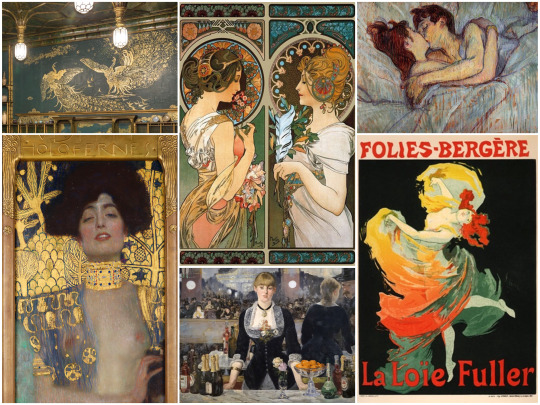
Artists Featured: James Abbott McNeill Whistler, Gustav Klimt, Alphonse Mucha, Henri de Toulouse-Lautrec, Édouard Manet, Jules Chéret
Stella’s main art aesthetic is the Art Nouveau movement. The colors and sense of movement really remind me of Stella, I think she’d happily decorate her entire house in gold like the Peacock Room (top left corner). I’ve also included a few Impressionist artists who I think Stella would appreciate, partially because GAY (the top right painting is usually read as two women hehe) and because the Impressionist movement was all about breaking from tradition which is very Stella.
I can really picture Stella in Paris in the 1920s (probably trying to flirt with Zelda Fitzgerald) and I think that’s why I chose some of these works.
Art movements/styles: Art Nouveau, Impressionism, Renaissance
Honorable mention for her is just Renaissance art in general , especially
La Primavera by Sandro Botticelli
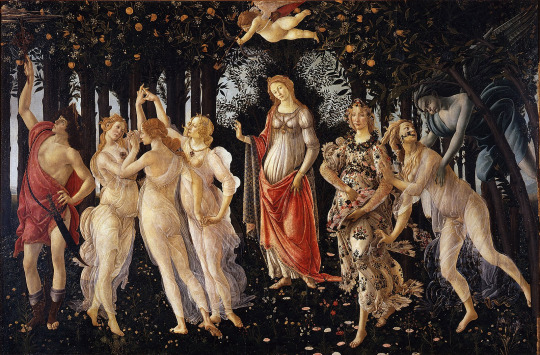
Part of Stella’s post-canon route is that she’s a patron of the arts, and might even open a museum in Vesuvia (we’ll see lol) so due to the general time period, I think the canon art she’d be commissioning and collecting would be Renaissance and Baroque art.
#i had so much fun with this omg#i will gladly talk more about art at any point#apprentice beatrice#apprentice stella#talking about art makes me so 💗💗💗💗#so thank you for asking laura
9 notes
·
View notes
Text
Painting By Numbers : Lydia & Arthur
TIMING: Current PARTIES: Arthur & @inspirationdivine SYNOPSIS: Arthur and Lydia are hired to restore a painting, little do they realise what else comes with the canvas. TW: None
When Arthur had received a rather cryptic call from Fran about the possibility of restoring a painting she couldn’t outright name that had unfortunately been damaged in transit from the Uffizi Gallery in Florence, his interest had immediately been piqued. There were countless in their collection - a great number of masterpieces and to have a chance to stand near to any one of them for any brief period of time would be an honour. Let alone to add in some small fashion to a legacy that had been revered and deified across the centuries. Apparently, it was such an important piece there had been a second specialist called in to aid in ensuring the job was done to the highest quality.
They were scheduled in for a week possibly more or work on this piece which had been placed in a moderately sized climate-controlled workshop attached to the gallery for any such necessary works. What Arthur hadn’t anticipated after swiping in with his ID on the reader and walking past a couple of security that were apparently an attaché to the painting was to come face to face with the one and only primavera. “Holy shit,” he breathed, the words hushed in reverence as he looked upon the intricate and detailed masterpiece that rested on a stand. Lifting his glasses up for just a moment to admire the piece with his natural sight before returning them to the bridge of his nose with a shake of his head, mesmerised by the piece. “Been a while since I’ve seen one of you…” he whistled under his breath, Fran hadn’t been joking about this one being important.
It wasn’t altogether uncommon for art restorers to collaborate on a piece together, although this was certainly the first time Lydia had collaborated with someone in White Crest. She’d heard of his work before, this Arthur fellow, and had only heard good things. So the call had been entirely welcome, although she wished she’d had a few more details as to the nature of the piece before she had arrived. Lydia stepped into the workshop and set down her bag by the door, before walking over to where the gentleman was that she was supposed to be working with. “Good afternoon. You’re Arthur, am I right?” she asked, offering her hand to shake as she turned to face the painting he was admiring. “Oh, wow, this is a beauty.”
Arthur was completely taken with the piece, it wasn’t often these days he could stand in the same room as something so magnificent. So Arthur was going to take all the time he could to appreciate this piece of work. That said, at the sound of footsteps approaching Arthur turned smoothly and smiled warmly at the woman approaching, “and you must be Lydia, I think we’ve spoken a little online yes?” he greeted in kind. Taking her hand to shake it, though the action while meaningful was brief to minimise skin-contact with him soon retracting his hands and tucking them into his pockets. It was hard to explain to people the excessive heat that seemed to radiate off him at any given time that was exceptionally noticeable on contact so it was easiest to try and minimise it if possible. “It’s stunning isn’t it? Have you seen a Botticelli before? It’s been an age since I’ve stood in front of one.”
“Yes, I believe so! You recommended the lighthouse as a viewing point. You were entirely right, by the way.” Lydia took his hand ever so briefly, thinking little of the warmth she felt ever so briefly. She turned her attention back to the painting, breathing deeply. Oh, you could see the Leanan Sidhe inspiration in this piece too, woven in to the inherent beauty of the piece. “Never for me to work on. I’ve seen one or two in private collections, recently.” She frowned as she heard a faint buzzing sound. “Oh, this is the worst part of summer. Insects get everywhere.”
“I did, yes,” Arthur’s grin brightened considerably to hear that she thought it was a nice place to go, “quite a vista up there wouldn’t you say? And rather peaceful with the waves rolling in.” But their respective attention turned to the masterpiece in the room. “No, I’m not sure that work of this calibre typically graces White Crest’s shores… But in this instance I suppose primavera has come to treat us both.” He stepped aside to where a few sets of gloves were placed alongside the necessary tools for the gouges that seemed to have taken out a fraction of Zephyrus’ face and Venus’ robes. He was pulling on a pair when Lydia spoke and he looked up “bugs? I didn’t notice anything when I came in… And I know Fran is particular about making sure this room is controlled to the best of her ability. Do you think it will be an issue?”
“No, I doubt it does, and certainly not on display that often.” Although Lydia knew first hand now that the inhabitants of Harris Island were sometimes older and much richer than one might assume. Or, thinking of Mercy, that they were more than eager to steal things that weren’t hers. “Do you have the report of what previous work was done on this piece?” She asked, slowly beginning her own analysis of the piece. Previous layers of paint and repairs - the back of the canvas revealed so much, like careful repairs to tiny tears. “I certainly hope not. I know Fran is meticulous, but… it is irritating. Can’t you hear it buzzing around?”
“No, it’s quite a gift. I just hope those that do get to see it can truly appreciate it for what it is,” Arthur remarked tilting his head to look once more at the figures poised within the frame. The classic Botticelli style apparent within their stances and the lengthened stature of their bodies delicate yet bold in its portrayal of the scene of Venus’ garden. “Yes,” he picked up a bound set of plastic wallets. “According to this the last restoration work done on it was around 1978 to restore the colouration of the paint which had darkened considerably over time.” He set the folder down once more, a small furrow appearing at his brow as Lydia drew his attention to focus on the buzzing. It was only when he moved nearer that he heard it, “oh dear… that’s not good.” He squinted wondering if he might be able to see what was making the noise but nothing came to view “can you see anything? I can hear the blighters…”
“I’m sure they will. How can you look at a piece like this and not appreciate it?” Lydia replied, reaching behind her to tie her hair back and out of the way so they could work. She picked up the plastic wallets, flicking through them to see what varnishes had been used and which had been removed. At least the last restorer had been meticulous in their notes, leaving a long trail of clues for Lydia and Arthur to follow up on. "I haven't the faintest idea where it is," she replied, as she heard something buzz right close to her ear. Lydia rubbed the back of her head. She froze, her fingers hovering over the skin just behind her ear, where her skin was swollen. "That horrible insect has bitten me!"
“You would hope so, unfortunately not everyone has the patience art often requires - particularly in this day and age.” It was a shame but not so many people wanted to walk through a gallery and few cared for the interpretation and meaning behind the pieces often put up on display or so he’d found. “That’s strange…” he remarked looking around and trying to spot the blighter, it was at Lydia’s exclamation that Arthur saw the bright emerald green critter just over her left shoulder. “There!” he tried to wave it away from her but it was faster than he’d anticipated, dipping mid-air out of the course his hand had taken and flitting behind him. Turning around to try and spy where it might’ve gone his eyes pivoted around the shop finding nothing but thin air. “That’s strange I was certain it was-- it was--” Arthur frowned, not realising the creature he was looking for had blended in with his own hair a mildly perplexed look crossing his features as a mildly disorentating sensation started to overcome him.
“Hey sweet pea, are you alright?” The woman speaking sat on a stool, holding a paintbrush in her left hand and easel in her right. She was tall and willowy, greying hair tied in a tight bun. She’d been painting, but not all of it was on the canvas in front of her - she’d painted her thighs, the easel, the window by which she sat. The girl she talked to glanced in the window, to find herself amongst the park scene her mother had been painting. It was dark out, so the windows were a mirror. Unlike her mom, her skin glowed. Where her mother had brown eyes, hers glowed blue, her teeth glinted pink, and her wings fidgeted uncomfortably. It was Lydia, still acne ridden as a teen. She held a loaf of bread in her hands, that she was slowly chewing.
“Mommie, I’m so hungry.” Her voice was plaintive, confused. Her stomach felt so heavy and thick, but her body still growled for more. She felt queasy with that gnawing, terrible hunger.
“Your father will be home soon. He’ll explain, my dear. You’ve just started early.”
“Started what early?”
Lydia’s mother stood up. She didn’t share her daughter’s ears, nor eyes, nor wings, but in so many other ways they were spitting images. They held themselves the same, and while Lydia’s hair was made of pearl it was undoubtedly her mother’s colour. Her mother smiled, cradling Lydia’s face in her paint covered hands.
“You know your father can explain better than I can. You’re being so brave, my dear. Just one more day, and he’ll help you.” She pressed a kiss to her daughter’s forehead, and Lydia hugged her gratefully.
Her mother staggered, and Lydia’s stomach felt less queasy.
“Oh non, pas encore!” the view followed a disgruntled man in his mid-fifties dressed in a sapphire blue tunic, black breeches and muddied riding boots as he swung down from the back of his mount who pranced with nervous energy. The moon sat high on the horizon illuminating vast farmlands otherwise deserted at this time of night as he walked towards the stone cemetery.
A group of three or four alghouls perched around the dug up remains of a grave busy stuffing their faces with decaying flesh and bone. The man turned moonlight reflecting off familiar features: Arthur, but older, black hair streaked with grey at the temples and a braided beard as he trudged into the space a familiar axe engraved with runes drawn from the scabbard on his back and a confidence of having done this several times before.
“Ça suffit,” the blade glinted in the moonlight before with a crunch it lodged in the neck of the first alghoul and dislodged with a forceful kick the other three hissing in anger and lurching back in surprise at the assault as a second swing had the head cleaved clean off leaving it twitching on the ground. How many times? They never learned.
The alghouls gnashed circling, but kept their distance taking the time to try and flank their prey. But as the second and third darted forwards, the axe was swung again, cleaving one clean through the shoulder near its neck causing it to wail inhumanly and topple ass over teakettle into a nearby set of rocks. But the third was faster, latching on to Arthur’s shoulder and biting down with razorlike teeth and ripping away with a bloody chunk of flesh drawing out a pained cry as he jabbed the tip of his axe forwards to pry the creature loose and shove it away staggering back panting with the effort. The second was trying to right itself, but limped from the tear of the freshly sharpened blade and where it tried to dive forwards Arthur side-stepped and grunted as he drew the axe back and down dispatching its head that rolled to a stop near another grave.
The scene played on, assailants taking swipes out of one another until a bloodied Arthur seemed to come to a conclusion and where he stood in the middle of the cemetery flames erupted around his body. A living pyre of flame and heat in the silhouette of a blazing gold and orange bird soaring up amongst them that had the two remaining alghouls screeching and trying to turn their eyes away as they stumbled, blinded. Using this to his advantage he lunged forwards, and two more heads were added to the pile as the flames died away leaving Arthur alone once more bleeding but alive in the middle of a graveyard. Exhausted, he dropped to his knees besides one such grave touching the piled stones carefully. “You’re safe… I’ll protect you.”
Lydia crumbled to the floor of Fran’s workspace. It wasn’t that the bite hurt, but it was the feeling that she had left something in the other room, although she never had. Something was missing. Unlike memories that faded over time, crumbled, but this was a sudden, sharp loss, something she couldn’t identify. The more she tried to remember, the more she tried to chase whatever it was she’d forgotten, the more she found something else. It sat in her head jarringly. Whatever it was, definitely not hers.
She saw it through his eyes. He was tall, his axe glinting in the moonlight. Lydia recoiled as he charged through the monstrous beasts, slashing into their necks without flinching. She remembered how the adrenaline had charged through him. She could smell the rain and mud as he worked, methodically. Lydia recoiled as she remembered the sharp pain in her shoulder. She - or he - was surrounded, the beasts readying to draw their last breath. She remembered weighing her options, both not what those options were until her skin burned, and erupted into flames. What followed was exhilarating, terrifying. Nothing like Lydia had never seen nor heard of.
Lydia blinked away the memory of the gravestones uncomfortably. “What was that? Did you see that? The man in the graveyard?”
Arthur wasn’t sure how he managed to stay standing at Lydia staggered and fell, perhaps it was the strange sense of fulfilling nourishment that seemed to have filled him as he blinked out of the strange vision that felt so achingly familiar. Away from a place that felt like home to the rather jarring appearance of a painting on a stand and Fran’s workshop.
How had he forgotten about that? No, he hadn’t forgotten… Or had he? There was a keen sense of something missing and yet in such a vast catalogue of memories who could say for certain? He’d forgotten many things over the centuries. His mother and father’s faces lost to the river of time. Yet this felt like an acute and sudden loss and the more his mind chased after whatever it was that felt as if it had been taken the more his head started to ache.
His hand went to his temple rubbing it at the throb and thinking back to the little girl and the painter. “See what? The little fae girl and her mother… She was painting I think,” his confusion muddled his mind enough that it didn’t catch up to what he was saying or who he was talking to. But Lydia’s own statement made him freeze for a moment, searching back because there were many graveyards but… “No... “ he said uncertainty lacing his tone, “what man? What graveyard?“
“What fae girl?” Lydia asked, standing upright sharply. What did he knew about fae? He was just some random art restorer. Except that he wasn’t in any sense of the word, if he knew what fae were. So now the question was how he knew and why. Nosy humans and monstrous hunters knew what fae were as much as every other species, but those were the ones that concerned her. “I don’t know. Maybe I’m misremembering. Do you think… Can you hear the insect? Do you think it bit you?”
The sudden change in demeanor was alarming but the more Arthur thought about the memory and looked at Lydia the pieces seemed to fit together. “I saw you I think…” there was still doubt in his voice but he could distinctly recognise certain symmetries between the girl in his memory and the woman before him even if other features didn’t match at all. But then again fae glamorous were powerful “and your mother? She was a painter too.” But if he’d seen that… Arthur’s frown deepened at her mention of being bitten, a hand going to rub at the nape of his neck in discomfort at the situation they’d been placed in. It was only then that he felt it, the little bump “oh that little bugger” he cursed his eyes widening in alarm at the dawning realisation. “What was he doing, the man in the graveyard?”
“There’s no way…” Lydia swallowed. Except that he was right. She didn’t remember much of her mother, or rather, she chose to forget as much as she could of the human woman who had withered throughout her teen years. She’d been a painter. Lydia still had some of her paintings, hidden in the deepest recesses of her home. “Whatever you think you saw, you’re… surely you’d have to be mistaken. How might you ever see such a thing?” Her stomach turned as she danced too close to a lie. She looked up to him, with deep concern. “Let me see,” Lydia said, stepping behind him hesitantly. “You have two bites. Another… there. The man in the graveyard, he was fighting. Ghouls, possibly?”
The denial earned a crease in Arthur’s brow, “but I remember it… Like it’s right there.” It was strange and perplexing to apparently have someone else’s thoughts at the very forefront of his mind. Like a strange intrusion of privacy that he had no right to view and yet they were stuck right there as if they were his very own. The song and dance Lydia - if she was this fae girl in his mind was understandable, but what was more concerning was what she might’ve seen. “Magic for one. Or a bloody magic bug.” He didn’t protest as she stepped around, pulling the collar of his shirt down and tilting his head forwards. His concern rose at the news he’d been bitten not once but twice, “what? Oh bloody hell…” He stepped away, scrubbing a hand through his hair eyes bewildered at the prospect of revelation by something so simple. What were the chances? They were both in it now. He grabbed a piece of paper and pencil starting to scribble a rough artistic impression of an axe with ornate filigree embedded on its metal turning he held it up. “Was he using an axe? Double headed? Like this?”
Magical insects. Lydia, in theory, knew that they existed, but she’d never been bitten by such disgusting creatures before. She shuddered, grossed out as he grabbed a piece of paper. Peaking over his shoulder, Lydia nodded, her mind going the same way Arthur’s was. She twisted her ring around her fingers as she watched him sketch the piece, cogs clicking into place. He knew something about whatever she had remembered, in the same way that she recognised his own vision’s description, if perhaps not in its entirety. Lydia had spent so much time with her mother when she’d been a child. “Indeed. I also felt an immense fire. Was he, perhaps, you?”
“Ugh,” he grimaced at the thought of being bitten by something foreign and unknown, in the name of Frigg, he hoped there were no magical diseases that could be contracted like that. That’d truly suck. His hand rubbed the little bump uncomfortable with the thought and the other thoughts that weren’t his own rolling around in his head. Perhaps it would have been smarter to play dumb, act like he knew nothing but there was a quiet kind of excitement that came with finding someone else… Someone unique. And her mention of burning well, Arthur huffed as he looked down at the sketch. The question was posed and Arthur lifted his head paper held gingerly as he tried to mentally compare the little girl he’d seen in a reflection to the woman standing before him now. “Perhaps, but I guess that answer would depend on whether you were the fae girl I saw.” Quid pro quo was a funny sort of deal after all. The fact she hadn’t bolted was a pretty telling sign in itself. “But... yes. I think you saw one of my memories… Just as I saw one of yours - you said you were bitten earlier didn’t you?”
“Which is an answer in itself, is it not?” Lydia smiled. “Fortunately for the both of us, neither of us appear to be human. Although I must admit I have no idea what you might even begin to be. You don’t think there are others, do you? I don’t know how to search my mind to find missing memories. Most are just remembered at the most inopportune times, when you smell something or hear something that reminds you of them.” Lydia sighed deeply, sitting down on a nearby work bench. “I hate this. I didn’t really mean to come here today to intrude on your past.”
“Well, sometimes there’s a joy in being mildly cryptic” Arthur smiled a little bashfully raising a hand to rub at a patch of skin just behind his ear in mildly erratic nervousness. “Apparently not… Which I suppose makes this uhhh- beneficial? I don’t make a habit of typically sharing that- well, my secret with strangers.” The claim to not know earned a quiet huff of laughter as the paper was set aside and he clasped his hands together bracing his elbows on his knees. “I’m… well, what some would call a phoenix. But I’ve been called a great many things over the centuries. Messiah, miracle worker, wiseman. It’s funny watching people trip over themselves trying to label what they don’t understand.” His smile turned into a mildly bemused expression as he thought on the question, “I don’t recall seeing any more… You said I had two bites? So it must have bitten both of us twice… And I guess taken and then transferred a memory with each subsequent bite.” His expression softened into something more amicable, “nor did I plan to intrude on yours. But I suppose we’re here…” His eyes glinted amicably as he processed the information, “but I guess we find solidarity in the strangest of places don’t we?”
“No, I don’t either,” Lydia replied, running her finger over the bite on her own neck. Imagine if he’d been a warden. Lydia pushed away the thought abruptly. That was more than enough considering of her death today. It was just a memory, not even the ones she valued so highly, of her terribly human mother. Who would have almost certainly died not long after he’d seen it. So why did her heart ache for the loss of it? Lost in her own thoughts, she almost missed his initial description of himself. Lydia raised her eyebrows very high as he described all the names he’d been given. “I imagine I’ll stick with phoenix, if it’s all the same to you,” Lydia chuckled. She kicked herself off the table, and back on to standing on her feet. “At least it is solidarity.” She smiled weakly. This memory wasn’t hers, and it felt like he’d been robbed of them. She might as well return them. “You were speaking in french. The moon was out, but it had rained recently, you could smell the wet dirt of the farmlands. There were monsters digging through graves. That you fought with that axe. One bit you…” Lydia pressed her hand to her shoulder, to show where he’d been hurt. “But you beat them. You were looking at a grave, and promised that you’d always keep them safe. It meant… The grave meant a lot to you.”
How many more memories would he lose? If not to magical creatures and parasites then simply to the ebb and flow of time. Had it not taken enough already? Arthur couldn’t even recall the face of his mother, or his sister or his brothers… Did he have one or two? There were only ghostly outlines of indistinct people with dark hair and kind eyes. Was that right or just his imagination? He’d never know. At least with more recent events he had a little longer with which to keep the memories. He listened to Lydia speak trying to place the thoughts of where they might fit. French was hardly distinct nor was the act. “I’ve protected too many graves…” a wan look crossed his features but the nearest he could place it was “maybe 12th century at a guess… Our gravesite was always being ravaged.“ Thinking of the memory he had Arthur folded his hands, pressing them together before he spoke in turn. “You were a teen standing near a windowsill with some bread… Your mother was painting… It was beautiful. But you were hungry… She said your father would help when he got home and then she hugged and kissed you. She didn’t look very well though…”
“Twelfth century? That’s… beyond belief. What a difficult memory to lose.” Lydia said softly, her eyes creased with empathy. That disappeared the moment he started describing what he had seen. It was as if a cloud had descended over her. “She would have died not long after that.” Lydia shook her head abruptly. She knew what he could not - that her mother’s hug had been what sustained Lydia. That just being around her had been enough for Lydia to unknowingly and unwittingly drain the life from her. No kiss required. Her father should have known better - her siblings had all taken years to control their hunger, and while growing up in an Aos Sí had protected her well, he should have never let her mother around her for so long. He should have never had children with a human to begin with. His love had killed her better than any knife. “There’s no need to dwell on such things. If you see the insect, let’s crush it before it takes any more.”
“I’d lose it eventually anyway,” Arthur admitted, his expression a little more misty than it perhaps was before. “There’s not much to be done for old age, hm?” A touch of humour in the face of a sad reality. “Oh… I’m sorry-- I didn’t realise...” it was his turn to look apologetic after all how could he, a glimpse of a moment of fractured time that didn’t belong to him, “I’m sure you miss her a great deal.” After all, what child didn’t miss their parents in some capacity? Not that he knew anything of Lydia’s life but the fragment seemed to show a good home with kind people. He grew quiet after that, clearing his throat a fraction “you’re right… It seemed to be coming from near the painting originally wasn’t it? Perhaps that’s where it was hiding.”
“All the same,” Lydia replied, looking into his wet eyes with concern. “I do not wish to discuss my mother, if I’m honest. It was a long time ago. She was not as good a mother as she could have been.” In that she wasn’t fae. In that she had never deserved to be a fae’s mother. Lydia’s heart felt tight all the same. She looked around, wondering if she might spot it wandering along on a surface. She picked up one of her big books, walking around with supernaturally silent steps. Lydia walked half way around the room before spotting it, a big bloated beetle resting against the table. Using her enhanced strength a little too keenly, Lydia smacked it with the book, and it squelched against the counter. “If nothing else, it’s dead.”
“Oh…” Arthur echoed unsure quite how to follow up a comment like that. So he chose to not say anything, sometimes it was better that way. Instead, he helped in scouring the room searching for any sight of the thing that might’ve been responsible. But ultimately, Lydia served the final blow, squishing the bug under a finer points to art book. “Well, at least it won’t be an issue for anyone else… I wonder how many other people it’s done this to.” It was a little disquieting but at least it was dealt with. “I suppose now that that little fiasco’s dealt with… Shall we get to work on this painting?”
“I hate insects ever so much. Which I realise is ironic considering my own beetle anatomy, but eurgh. Keep them away from me. At all costs.” Lydia shuddered at the corpse remains of the insect, squelched on her book. She looked up at Arthur with a smile. “Yes, let’s!” As she picked up her tools to start preparing to remove it from the frame, though, she couldn’t shake the memory of fire bursting from her body. Well, his. That quiet graveyard, and the ones he wanted to protect. He wasn’t fae, so… “Thank you for not pushing on the matter of my mother,” Lydia said softly, before turning all of her thought to their work, and enjoying the pleasant company of the ancient gentleman beside her.
Arthur couldn’t help but laugh quietly at the irony presented and while he could recall the reflection of what she had looked like, he couldn’t help but wonder what she actually looked like behind the glamour. His head tilted a little in acknowledgement, “you’re welcome. I understand some things aren’t the sort of things you want to talk about with strangers you’ve only just met.” He opened a small collection of tools attention focussed there for the time being. They’d need to file the gashes down and repaint from there and he had so many questions he wanted to ask. “I doubt you get much opportunity to not hide your true form do you?” Arthur remarked after a little while of working “I can only imagine it must be tiring… Hiding what you are day in and day out, it’s rather impressive. The capability of fae glamours… I’ve always wondered - does creating them get easier with time?”
Lydia nodded in response to his comment, and let sleeping lions lie. It twisted her stomach enough to just think about her mother, let alone have someone else know it. They worked in quiet for a moment before Arthur interrupted. “It is like maintaining good posture. After a while, it’s second nature to hold that tension in place. It requires thought, but I’ve worn this same face for decades. Same wrinkles around the eyes, pock marks, venation. It’s like putting make up on.” Lydia shrugged. “How does it feel to have lived so long?”
“Huh,” he mused thoughtfully, “it’s something I’ve always wondered… I’ve never really spent much time around many fae considering I know most of your kind prefer to stay in your own communities…” Arthur looked back to the painting considering the work “you think you’ve seen the breadth of what lies on the spectrum of the supernatural and yet there’s always so much you find out you don’t know.” He resumed working, hands moving in slow methodical strokes as he worked the groves down wondering how best to answer a rather loaded question. “Honestly it really depends on the day, some days it’s exhilarating - especially when there’s a new discovery or invention… Other days it feels like you’re carrying the weight of the world on your shoulders… It’s easier to begin with - when you don’t remember and life is just… life.”
“We often do, but not always,” Lydia agreed. “Then again, I hadn’t been too sure Phoenixes really existed until just now. Even for us, separating fact from fiction can prove challenging.” When he worked on the canvas, she didn’t, so that they weren’t applying tension unevenly, and didn’t want to knock each other. She focused on the solvents, the paints, setting things up for each next step. “That sounds like an intense existence. I am so old to so many here, but I am a child to my peers. My age compares nothing to yours, and yet it’s hard to imagine another three life times after this.”
“We’re a more inconspicuous type than most, I’ve never met another one of my kind in all the time I’ve been alive” Arthur admitted his brow creasing a little with the admission. How many were out there really? Who could say for sure. “It can be. Considering we have to restart our lives from scratch each time…” His smile grew a fraction, a knowing look passing his features “it takes time but you often end up coming to terms with it eventually… It’s different though - a sustained life and existence over that extended period you know? Fo rme it’s just like someone hitting reset every century.”
“That seems to me to be rather lonely,” Lydia said softly, listening to him curiously as he talked about his rebirth. She could not imagine. “There are many, many things one can get used to with enough experience, I suppose,” Lydia replied, trying to imagine it. Dying and restarting life afresh, over and over. She shed her name with frightening frequency, but she still remembered her past, and did not let go of those she loved. She wondered what Deirdre thought of it, people who died and lived over and over, with each new rotation of the clock. She had such interesting perspectives on death.
“It is, but you learn to move on, you have to or what’s it all for in the end? Plus I often meet people along the way that make it worthwhile. Like today I made an unexpectedly new friend.” Arthur smiled at her, eyes creasing kindly even if there was sadness with the admission. So many lives had flickered in and out of existence. So many friends gone and lost to the trial of time. But today he had made a friend, and in his mind that made today a good day.
She didn’t reply to that. Being Fae was fundamental to her identity, being part of the fae, that she couldn’t imagine being without them. People were fine, but fae were best. They deserved to be around each other. Lydia’s heart ached for people like Jared, and Regan, who had lived without other fae for so long and had ever so clearly suffered it. Lydia grinned back at him. “Boticelli and bugs sure have a way to bring people together, I must say.” She winked, and turned back to her work, cheerfully.
“Who knew?” and so the afternoon drifted on, light chat intermingling their progressive work in restoring the damage done to the painting. It would take around a week to complete but in good company Arthur was happy to take the time to do a job right, plus, if he’d made a new friend out of today’s shenanigans then there was nothing really to complain about. Maybe bugs weren’t so bad after all?
10 notes
·
View notes